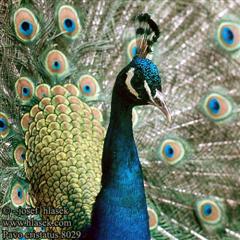Peafowl - India Blue
India Blue Peacock Scientific Name: Pavo cristatus
Sat, 5th July, 2025 - 8:48 pm GMT
Sponsor Ads:

Alternative Name
India Blue Peacock Scientific Name: Pavo cristatusBasic Info
The India Blue Peacock is directly related to the pheasant in both genes and size. The main difference between the two, in fact, is the Peafowl's beautiful plumage, which they do not develop until they have reached at least three years of maturity. The males are called peacocks, the females peahens, and the young offspring peachicks. If you have ever seen a peacock in a zoo or park, chances are extremely high that it is an India Blue Peafowl. In appearance, they do have a few variations. These include the white, the pied, the black-shouldered variety, which occurs in males only and causes the wings to be blue, green and black, and the rare Spalding variety, which is a crossbreed between the India Blue and the Green Peafowl.
Health
India Blue Peafowl are not fussy eaters and can sustain health easily on the diet of most any gamebird. This may consist of mixed grains and a variety of greens. India Blue's will also eat shelled and cracked corn, rabbit pellets, oats, dog chow, seeds, grass and insects. India Blue Peafowl are very hardy birds that are best kept healthy by regular worming (at least twice a year). This does not require much work, as there are several wormers that are available that can be given orally or mixed within the Peafowls' drinking water. Otherwise, plenty of room to wander and explore should keep your Peafowl healthy and happy. Breeding Both the Peahen and the Peacock are generally ready for breeding in captivity at two years of age, though the male Peacock does not reach full maturity until the age of three, when his full train develops. The Peacock's train is helpful in breeding, as it begins to molt at the end of the summer, marking the end of the breeding season. One Peacock of mature age can generally mate with up to five Peahens in one breeding season, though mating Peacocks with Peahens, which are relatives, is not recommended. India Blue Peafowl breed well either in a cage or out in the open where they are allowed to wander. Should you decide to breed them in a cage, however, it suggested that the cage or pen be at least 400 square feet. If a roof is attached, it should be well over six feet in height and roosts should be placed approximately 40 inches from the ground to keep the Peafowl safe from predators. Straw or hay should be placed on the ground to give the Peahen something from which to create the nest. The Peahen should begin to lay eggs in the early spring and continue, generally, until approximately seven to 10 eggs have been laid. The nest of eggs ("clutch") can number between three and 12 eggs, but somewhere between four and six eggs is the average clutch. The one exception to this rule is artificial incubation. If the eggs are taken from the Peahen and incubated elsewhere, she may lay up to 30 eggs before the breeding season is over. If artificial incubation is desirable, it can be achieved by incubating the eggs at approximately 99 to 100 degrees (Fahrenheit). After ten days of incubation, hold each egg up to a candle to check for fertility. If any egg is not fertile at that point, it should be immediately taken from the rest of the eggs so it does not ruin the other eggs. After 27 to 30 days of artificial incubation, the fertilized eggs will begin to hatch. Peachicks will reach full growth between the ages of eight and ten months.Habitat
N/ABehavior
Once a feast fit for a Roman, the India Blue Peafowl stands now as one of the most beautiful domesticated birds in the world. Out of the only two naturally occurring peacock species (the Green peafowl and the India Blue Peafowl), the India Blue has become the most commonly domesticated bird, having finally lost its attraction as a table morsel to the common turkey. This is probably due to the fact that the India Blue Peafowl has a more hardy constitution and can withstand more extreme weather conditions than its genetic cousin, the Green peafowl. The India Blue is also a more social and gentle bird, and does not generally need to be kept in a pen at all. They can escape in certain situations, but if their needs are met, they will generally stay put. Some breeders suggest mixing the India Blue Peafowl with pheasants (their genetic relatives), as pheasant males can sometimes treat their females harshly and the India Blue feels a duty to step in and save the pheasant hen from harm. Known for its beautifully plumed tail and gorgeous markings, the India Blue Peafowl stands as one of the easiest birds to both care for and to breed. Gentle in nature and temperament, the India Blue Peafowl will long continue to grace American parks and rural homes with their innate and striking beauty.Origin
IndiaHistory
In fact, in 1963, this heroic bird was declared the National Bird of India because of its deep and long-standing involvement in Indian traditions and religion!Common Foods
N/ASponsor Ads:
It's not social oppression that moves wild-eyed revolutionaries; it's envy, pure and simple. -- Unknown
Peafowl - India Blue
Coded by: BGID® | ALL RIGHTS RESERVED Copyright © 2000-2025
Disclaimer | Privacy | Report Errors / Contact | Credits








 President of the United States of America - Real Estate mogul, Pageant owner and now one of the most controversial men in political history.
President of the United States of America - Real Estate mogul, Pageant owner and now one of the most controversial men in political history.  Global warming has been in and out as the "latest" hot topic for many years. It is, according to modern scientists, the result of man-made industrial pollutants, clearing forested areas, agriculture, etc. But now they are thinking it started way before the Industrial Revolution...
Global warming has been in and out as the "latest" hot topic for many years. It is, according to modern scientists, the result of man-made industrial pollutants, clearing forested areas, agriculture, etc. But now they are thinking it started way before the Industrial Revolution...  Politician, US Vice President and President of the USA - Joseph Robinette Biden Jr.
Politician, US Vice President and President of the USA - Joseph Robinette Biden Jr.  versus
versus  Russia: 'The Evil Empire'? Are they all that bad or is it just the USA trying to portray Russia as bad because they are a world power with land bigger and a society very different from the USA ideal?
Russia: 'The Evil Empire'? Are they all that bad or is it just the USA trying to portray Russia as bad because they are a world power with land bigger and a society very different from the USA ideal? 
 Corona virus
Corona virus 
 Users with wide screen monitors can benefit from more content on every page.
Users with wide screen monitors can benefit from more content on every page.